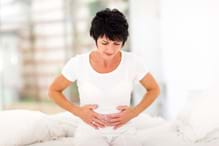Menstrual cramps are a pain. By even the most conservative definitions, well over 40% of women everywhere suffer from painful pelvic cramping, or dysmenorrhea, along with other disruptive symptoms before, during and after their periods. Cramps can be accompanied by heavy bleeding, mood swings, fatigue and bloating, and can leave some women bedridden, or missing work and other obligations every month.

Menstrual cycles last between 25 to 32 days, which means that some women spend one third of their lives suffering from cramps. That’s quite a burden on one’s quality of life. While reports vary on the way data are collected and which populations are surveyed, there’s little doubt that having intense discomfort with your periods is a global issue.
With all this evidence, why, did so many doctors dismiss menstrual cramps as a “myth”? As more about the physiology of PMS is revealed, we now understand that dysmenorrhea is a real condition, with genuine physiological causes.
And even better, if you have no serious underlying health conditions, you can alleviate menstrual cramping simply by giving your body the right support. Even deeply entrenched cases of menstrual cramps can be improved considerably with changes in lifestyle and nutrition that encourage hormonal balance.
Primary dysmennorrhea
Primary dysmenorrhea is crampy pelvic pain that lasts more than several days during your monthly blood flow. It can be accompanied by a number of related symptoms, including bloating, nausea, vomiting, headaches, backaches, pain that radiates down the thighs, and diarrhea. Primary dysmenorrhea is caused by excess prostaglandin. Prostaglandins are hormone-like fatty acids that send pain signals to the brain. These additional prostaglandins cause both the small muscle contractions in the uterine wall and the gastrointestinal symptoms that accompany dysmenorrhea.
This kind of spasmodic menstrual cramp is most common in younger women and often resolves itself as they get older. Many women also report their menstrual cramping dissipates after their first pregnancies.
Take note that sometimes a benign ovarian cyst, pelvic infection or an ectopic pregnancy can cause acute pelvic pain toward the end of your cycle. These conditions can be life threatening, especially if these symptoms are sudden and intense. If you are experiencing tenderness and sharp pain that does not subside with the onset of your menstrual flow, see your healthcare provider as soon as possible.

Secondary dysmenorrhea
Secondary dysmenorrhea is characterized by a congested, dull pain that begins as early as two weeks before the start of your flow. This kind of cramping is more common in women in their 30’s and 40’s and usually does not get better with age. It can be accompanied by bloating, weight gain, breast tenderness, headaches, lower back pain and irritability.
Symptoms may be exacerbated by fluctuating estrogen levels, which in turn cause fluid retention. Traditional Chinese Medicine views this kind of painful period as a form of blood stasis, in which vital energy is unable to flow freely through the lower abdomen.
Underlying causes of secondary dysmenorrhea other than hormonal imbalance can include:
- Endometriosis (ectopic endometrial tissue)
- Ovarian cysts
- Adenomyosis (endometrial tissue within uterine wall)
- Pelvic infection
- Cervical stenosis (stricture of the internal cervical os, the opening to the uterus)
- Congenital uterine or vaginal abnormalities
- Fibroids
- Intrauterine device (IUD) — most commonly the copper IUD
Common risk factors for secondary dysmenorrhea include obesity, cigarette smoking, chronic pelvic infections and/or STDs. If you have persistent menstrual cramping that either remains the same or worsens over the course of a few months, schedule a check-up with your healthcare practitioner to find out what’s going on.
Moving on from menstrual cramps
If none of the above conditions is present, you’re a good candidate for natural menstrual cramp relief. A combination approach that includes medical-grade nutritional supplements, exercise and herbal support can make a huge difference in how you feel every month. When hormonal balance is restored, menstrual cramps usually ease up and often subside completely. Now that’s a relief!
1 MerckMedicus Modules: Dysmenorrhea — Epidemiology. URL: https://www.merckmedicus.com/pp/us/hcp/
https://www.merckmedicus.com/pp/us/hcp/diseasemodules/dysmenorrhea/epidemiology.jsp (accessed 08.23.2006).










